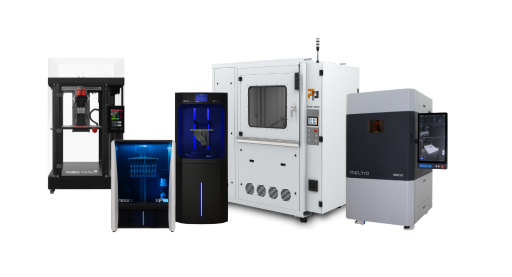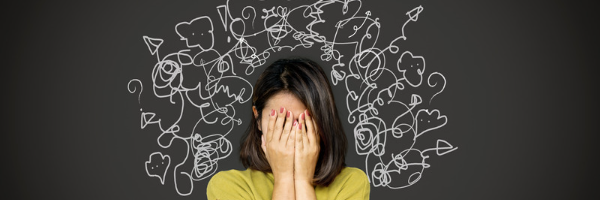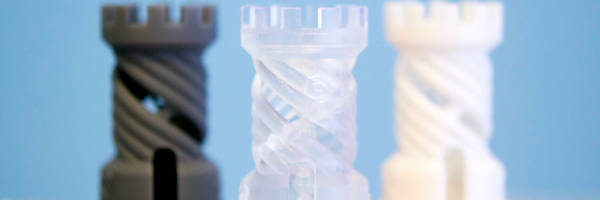3D printers
High quality 3D printers

The post-processing of resin components is essential. Additive manufacturing with resin requires several mandatory post-processing steps, without which the component is not functional.
These mandatory steps are cleaning, removal of support structures and post-curing. In today's blog post, I would like to go into detail about these three steps, explain them and point out possible difficulties and possible solutions for these difficulties.
After the print job has been completed and the build plate has been removed from the printer, the manufactured components must always be subjected to cleaning. This cleaning is done with a special solvent, mostly isopropanol.
Sounds simple at first. For very simple structures, such as a basic cube, it is. But when we move on to more complex structures, ergo components with small details, cavities, holes or the like, the cleaning process can quickly become a pain.
Excess resin must be completely removed from the component to maximize the quality and mechanical properties of the part. And it is this completeness that can become a difficulty with more complex structures.
The cleaning of resin components can be carried out using various methods. The most important of these are manual cleaning, cleaning with specially designed washing stations or an ultrasonic bath.
The cheapest, but also most labor-intensive method of cleaning resin components is by hand. The component is dipped into a tub of isopropanol and carefully cleaned of excess resin with a brush, ideally a hard bristle brush.
Unfortunately, the high amount of work involved in this method is not rewarded with better quality - on the contrary. Even after several cleaning cycles, there may still be residual resin on the component in the case of more complex structures.
Fortunately for us, however, we live in the 21st century and therefore no longer have to rely on manual work - thanks to machines and automation!
Washing stations are the most widespread method of cleaning resin components. Such washing stations virtually take over the previously described part of manual cleaning by "swirling" the cleaning agent around in the machine and thus removing the excess resin from the component.
Components cleaned by washing stations offer, in the vast majority of cases, a higher surface quality and require, in clearly all cases, less time than manually cleaned components. In the case of smaller components, several can also be processed simultaneously by the stations, which saves further time.
However, the cost of purchasing a wash station is far greater than is ever incurred with manual cleaning. While small and hobby washing stations can be obtained for as little as a few hundred euros, it is not uncommon for professional and industrial washing stations to cost several thousand euros.
Washing stations are therefore not really suitable if additive manufacturing is only done "on the side" or as a hobby. In the professional and industrial sector on the other hand, washing stations become unavoidable, as the time required for manual cleaning is not sustainable in this area. At the same time the initial cost is quickly offset by the enormous time savings.
As already mentioned, washing stations offer a higher surface quality than manual cleaning. However, if an exorbitant surface quality is required, another method must be resorted to.
Ultrasonic baths represent the highest-quality option for cleaning resin components, but also the one with the highest acquisition costs.
In this process, the cleaning liquid, in this case not isopropanol but TPM (tripropylene glycol monomethyl ether) or DPM (dipropylene glycol methyl ether), is excited by an ultrasonic oscillation between 20 and 40 kHz. This creates microscopically small bubbles, which implode again a short time later.
This implosion of the bubbles, also known as cavitation, creates a strong pressure and suction effect on the component, which virtually blasts off the resin residues and causes them to completely crumble.
Due to the high initial costs, this type of cleaning is particularly suitable for industrial operations or, as already mentioned, for components that require an exceptional surface finish, such as jewelry.

The greatest difficulty in this step of the post-processing is the importance of completely removing any remaining uncured resin. Especially with manual cleaning, several passes may be required to remove all excess resin - and even then, especially with complex components, there is still a risk that there will be resin in a groove or cavity.
But what is the problem if there is still uncured resin on the component? And is it possible to remove it later if necessary?
If there is uncured resin on the surface, the surface quality suffers. Since the component has to be post-cured at the end, the remaining resin partially hardens, resulting in unevenness on the surface.
If the resin is located in a cavity or a channel, for example, this can completely destroy the functioning of the component. If another component now has to be connected to the resin component, this is no longer possible because the remaining resin has now reduced or completely closed off the interlocking point.
Since the uncured resin is nevertheless cured by the post-curing process, subsequent removal is also impossible. So if the surface quality or functionality of the component has been restricted by remaining resin, it may be completely unusable after post-curing at the latest.
To save unnecessary work and costs, it is better to check the component once too often for residual resin. Even if washing stations or ultrasonic cleaners have been used! Just because such systems allow better removal, they are far from being completely free of failures.
Support removal can happen before or after post-curing - but it's easier to remove before post-curing, so I'm classifying it as a second step in this blog.
Support removal is about, who would have guessed, removing the support structures that are necessary in Additive Manufacturing with resin. Why this removal is necessary, I probably don't need to explain to anyone. I'd rather explain what 3 methods there are to remove these support props and the difficulties that can arise.
Of course, there is also the option of using good old manual labor here. Due to their often elongated shape, the support structures can be easily gripped and removed without too much effort.
However, this method should definitely not be used for components with smaller details. There, a strong jerk could be sufficient to break off one of the smaller details in addition to the support structure.
Manual removal will also leave small to medium-sized nubs on the component, but these can be removed with a bit of sandpaper and a little more patience.
Flush cutters are the safer method of removing support structures from components. Especially with more complex components, this safety is essential to avoid damaging the component.
The flush cutter is placed as close as possible to the edges of the support structures and then the structures are cut away from the component one by one. However, this method also requires more time than manual removal due to its higher accuracy.
Again, nubs will remain on the part, but almost certainly much smaller than with manual removal. This makes for less time spent grinding, which at least makes up for the more time previously required to remove the support structures.
The last option for removing support structures is water-soluble resin. This can be used to create the support structures, which are removed at the same time as cleaning.
This method also does not leave any nubs, which completely eliminates sanding. For this reason, this method is without a doubt the fastest way to remove support structures.
The only problem with this is that the 3D printer used must have the ability to print two resins simultaneously. After all, a component made entirely of water-soluble resin would not be particularly effective.
Such printers are mostly found in the professional or industrial segment. Only very few hobby 3D printers have this feature. If you want to make support removal much easier, it is therefore advisable to find out whether a printing system can print with multiple resins before buying it.

Both the time required and the difficulty involved in removing the support are in most cases less than in cleaning the resin component. Nevertheless, this post-processing step does have one major difficulty.
However, this difficulty lies more in the human factor than in the step itself - namely in a lack of attentiveness. Pulling too hard or cutting too carelessly can be enough to cause serious and, in the worst case, irreparable damage to a component.
Irreparable is the key word here - at this stage it is very rare to cause such damage. A broken detail can often be reprinted and attached to the actual component using post-curing. The risk of a complete loss of the component is thus much lower in this step of the post-processing.
Nonetheless, a broken detail means trouble, labor, and time. Therefore, one thing above all is required in this step - patience and caution. With these two qualities, support structures can be removed from even complex components without major problems. Or you can rely on a printing system that can print two resins at the same time and save yourself the need for these two properties - at least for this step.
Post-curing of resin components involves increasing the temperature of the component to improve mechanical properties such as heat resistance, strength, UV resistance and many more.
Before we get to the methods, it is important to note that each resin takes a different amount of time in post-curing. Therefore, before this step, it is imperative to check the manufacturer's instructions for use to ensure that the required time is met - but we'll get into that in more detail when we get to the difficulties.
Post-curing can take place through many different methods. The most important of these are exposure to sunlight and post-curing stations of various kinds.
The "green method" for post-curing resin components is a simple stay in a place with constant and uniform sunlight. Whether a balcony, a terrace or a window ledge - the main thing needed is a place with a lot of sun!
The disadvantage of this method is the much higher time needed for this post-processing step. While post-curing stations need a few minutes for this step, the natural method requires several hours.
The appearance of the surface is also different with this method than with post-cure stations. While post-cure stations produce a glossy surface, components that have been post-cured by exposure to sunlight tend to have a matte, opaque surface.
This method is, of course, only suitable for hobby use with simple components. And for people with time. For people with less time (and more money), post-curing stations are far more suitable.
Post-curing stations are systems specially manufactured for the post-curing of resin components - at least mostly specifically for this purpose. Theoretically, nail polish dryers can also be used as re-purposed post-curing stations, since they work with UV light. In terms of time, of course, this takes longer than classic post-curing stations, but the results are actually quite good.
Not just "quite good" requires professional help. Many suppliers of resin 3D printers also offer professional post-curing stations in addition to their printing systems, sometimes directly in combination with a washing station. These are available in a wide range of sizes, some of which are specially designed for manual use to precisely reach deep-seated cavities, and at various prices, from under one hundred to over ten thousand euros.
The component is inserted into these post-curing stations, with or without a build plate depending on the supplier, and then cured by several UV lamps simultaneously. The time is set manually, but in the vast majority of cases it is less than 5 minutes.
This professional assistance ensures the best possible material properties and a uniformly high-quality surface finish. For professional or industrial production, there is therefore no other choice than such post-curing stations.

If non-professional post-curing methods are used, the biggest challenge is the uniform degree of post-curing. On one hand, in order to have the mechanical properties continuous over the entire component, and on the other hand, to ensure a uniform surface finish.
The only way to counteract this difficulty is to combine it with, for example, a turntable or a record player. This allows the component to be rotated at an even pace, so that the UV light reaches all areas to the same degree.
Also, the amount of time a component needs to post cure is a bit more complicated with non-professional post cure methods than just reading the time. Since the time given by the manufacturer is mostly based on professional post-curing stations, they can only be applied there.
This difficulty can only be counteracted with one thing - trial and error. Regularly checking the part while it is under the UV light source should tell you relatively soon how long the resin used with the post cure method used will take to reach the best possible post cure level. However, if a different resin is used in a subsequent print, this trial and error will have to take place again.
Both of the difficulties mentioned so far relate to the use of non-professional post-cure methods. Do professional post-cure methods have any difficulties at all?
In short, yes, but not too much. The degree of post-curing is continuous by irradiation from several UV lamps simultaneously on all sides, and the curing time can be read from the material guide. Nevertheless, even a professional post-curing station can cause errors, especially with complex components.
However, if an error occurs in a component, irreparable damage is rarely caused even during this step. The vast majority of errors can be rectified by re-curing - albeit, as is so often the case, with an increased expenditure of time.

Finishing resin parts is a tedious process. The steps covered in this blog post include only those that are essential. In addition, there could be painting, coloring, polishing and many other steps if they are needed or wanted.
This makes it all the more important that the post-processing works right on the first try. The already high time expenditure does not have to be further extended by errors and their correction. In the meantime, post-processing also offers some automation options, which can reduce the amount of work and the error rate, and thus indirectly also the time required.
Post-processing of resin parts, whether with or without automation options, is full of pitfalls. I hope I was able to uncover some of these pitfalls with this blog post and present adequate solutions. If you need more information about post-processing solutions for resin parts, I can recommend this webinar*.
Otherwise, I wish you good luck with your post-processing. Here's to finishing all your parts without much difficulty!
*the Webinar will be held in Dutch.